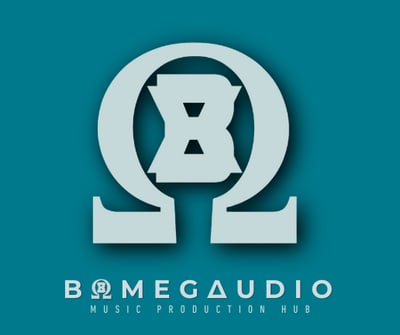Music ToneLine - Instruments Through The Ages
The Progression of Musical Instruments Throughout Human History
HARDWARESTUDIO TECHMUSIC HISTORYBOMEGACADEMY
5/26/202526 min read
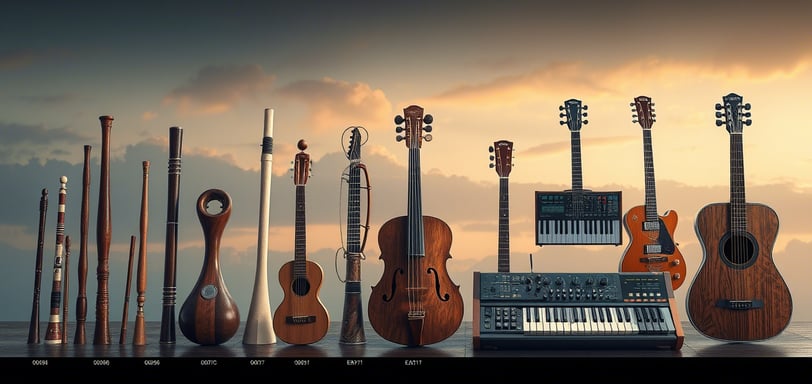

The Progression of Musical Instruments Throughout Human History
Music has always been a profound expression of human emotion, culture, and identity. From the hollowed bones of early flutes to the cutting-edge AI music generators of today, the evolution of musical instruments reflects our creativity, technological innovation, and connection to sound. This article traces the development of 20 key instruments that mark humanity's journey through the sonic timeline.
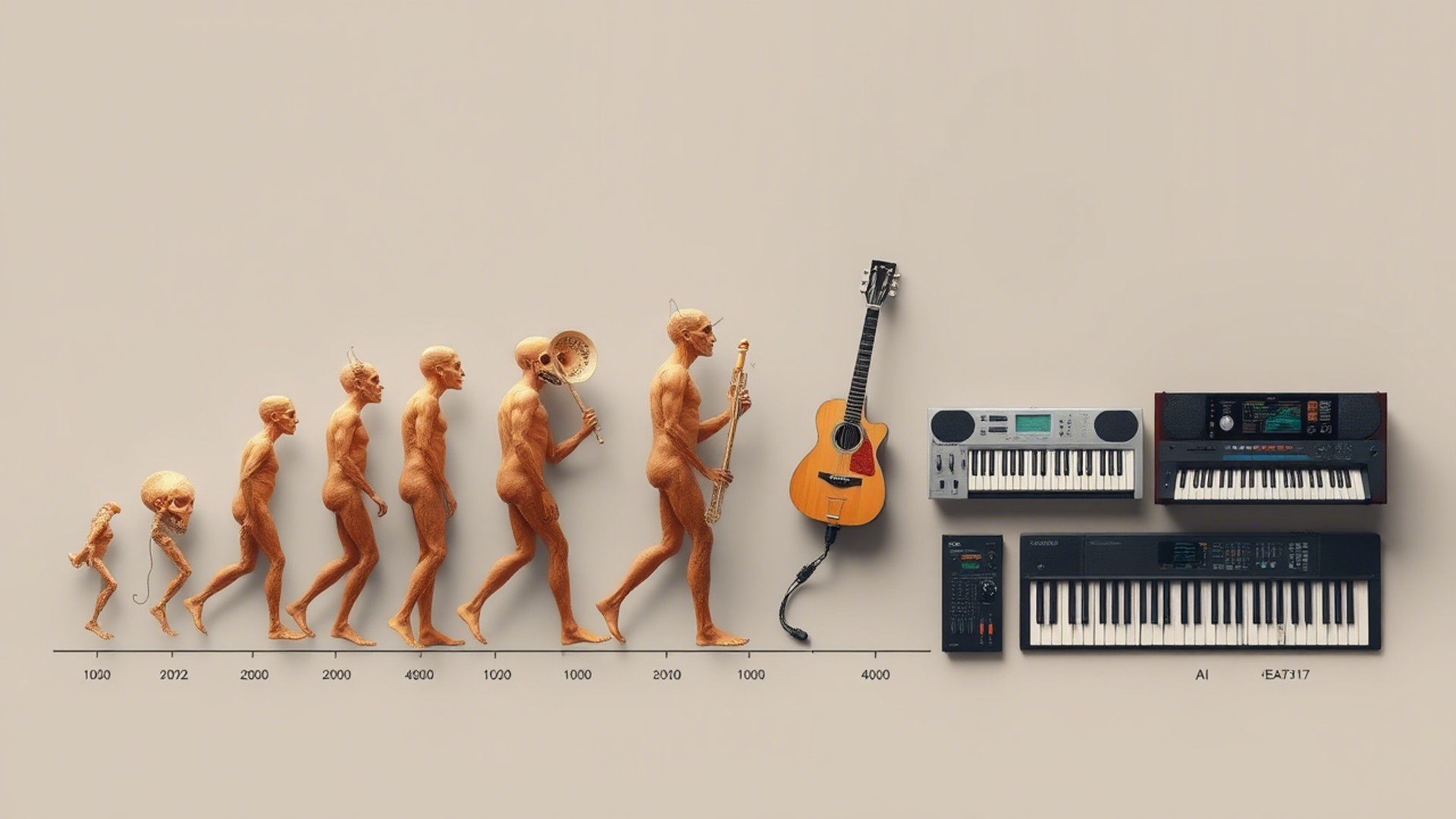
1.The Origins of Sound – Prehistoric Instruments
In prehistoric times, music was rooted in survival, ritual, and spirituality. The bone flute, bullroarer, and early drums weren’t created for entertainment but for communication with nature, the gods, or the tribe. These instruments emerged from the natural environment—bones, wood, animal skin—making sound a sacred extension of life itself.
The limited tones of the bone flute and rhythmic drive of primitive drums helped define early taste: simple, repetitive, meditative, and trance-inducing. Music was not yet a profession or craft—it was communal and spiritual. Bullroarers, with their eerie drone, were often used to summon spirits or mark territory, showing how sound held power and mystery.
This era’s musical preferences reflected raw emotional states and connection to natural rhythms like heartbeat, fire crackle, or animal calls. It laid the groundwork for how humans use music to feel, connect, and ritualize.
Neanderthal Bone Flute (43,000 BCE)
Discovered in Slovenia and made from cave bear femurs, these bone flutes are humanity's oldest known musical instruments. Crafted by Neanderthals, they prove that even our early ancestors understood the power of melody.


The discovery of the Neanderthal bone flutes in Slovenia has been a pivotal moment in understanding the origins of music in human history. Dating back to approximately 43,000 BCE, these ancient instruments highlight not only the musical capabilities of early humans but also their complex social structures and cultural practices. Crafted from the bones of birds, particularly the crane, these flutes exhibit remarkable craftsmanship for their time, suggesting a level of cognitive ability and understanding of sound production that has often been underestimated in Neanderthals.
The construction of these flutes involved creating holes along the length of the bone, allowing for different pitches to be produced, which indicates a sophisticated method of sound manipulation. The shape and size of the flutes vary, showcasing the artisans' experimentation with acoustics and a deep understanding of the materials at hand. This illustrates that music-making was not just a primal instinct but a meaningful activity likely integrated into their daily lives and rituals.
The significance of the Neanderthal bone flutes extends beyond their functional role as instruments. They provide insight into the social and emotional contexts in which early humans might have engaged with music. Music is often tied to communication, storytelling, and expression of emotions, suggesting that even in prehistoric cultures, there was a desire to connect with others and convey experiences through sound. As such, these flutes serve as a tangible representation of one of humanity's earliest attempts at music-making, demonstrating a shared aspect of our cultural heritage that transcends time.
In light of these discoveries, it can be concluded that the Neanderthal bone flutes not only mark a significant advancement in the development of musical instruments but also shed light on the cognitive and social capabilities of our ancient ancestors, propelling the study of music's evolution through human history.
Bullroarer (25,000 BCE)
Used across ancient cultures from Australia to Europe, the bullroarer produced eerie, whirring tones when spun. It was often employed in rituals, signifying how sound was deeply tied to spiritual and communal life.
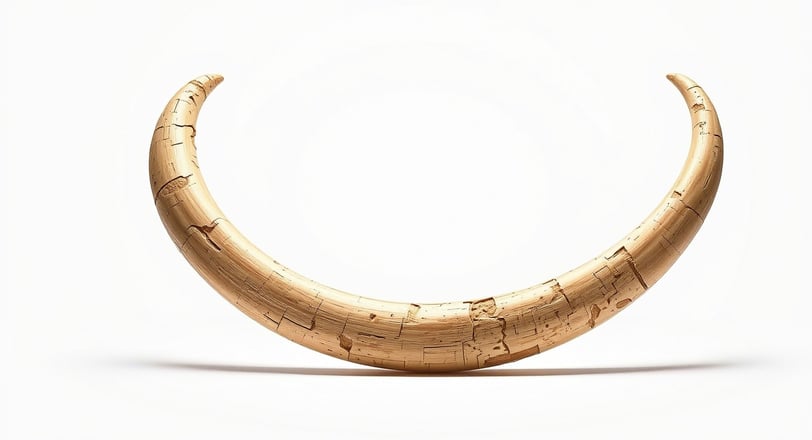

The bullroarer, an ancient sound-making instrument, boasts a rich history that dates back to approximately 25,000 BCE. This remarkable tool has transcended time and culture, providing insight into early human societies' lives and their methods of communication. Composed of a flat, elongated piece of wood attached to a string, the bullroarer creates a distinct sound that resonates in the environment when spun. The mechanics behind the sound production lie in the rapid rotation of the instrument, which produces a unique auditory experience as it cuts through the air, generating a continuous hum or roar.
Throughout various civilizations, the bullroarer has served multifaceted purposes. Among Indigenous Australian communities, it is often utilized during ceremonies and rituals, embodying connections to spiritual beliefs and cultural practices. Similarly, in ancient Greece, it was associated with initiation ceremonies and was believed to communicate between the living and the spiritual world. This cross-cultural use highlights the bullroarer's significance as a sound maker that extends beyond mere entertainment; it is an essential tool for communication, conveying messages over long distances and fostering a sense of community among early peoples.
The bullroarer, an ancient sound-making instrument, boasts a rich history that dates back to approximately 25,000 BCE. This remarkable tool has transcended time and culture, providing insight into early human societies' lives and their methods of communication. Composed of a flat, elongated piece of wood attached to a string, the bullroarer creates a distinct sound that resonates in the environment when spun. The mechanics behind the sound production lie in the rapid rotation of the instrument, which produces a unique auditory experience as it cuts through the air, generating a continuous hum or roar.
Drums (8000 BCE)
Frame drums crafted from animal hides stretched over wooden frames appeared in Mesopotamia. Percussion was possibly the first rhythm tool, giving structure to early communal dances and ceremonies.
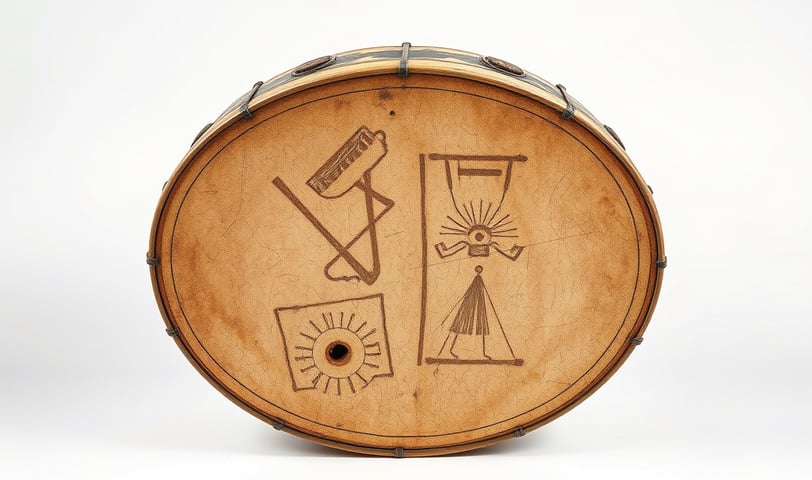

Drumming has played a pivotal role in human culture since ancient times, particularly in Mesopotamia, where some of the earliest frame drums were discovered, dating back to approximately 8000 BCE. These instruments, crafted from natural materials available in the region, reveal much about the technological and artistic abilities of ancient civilizations. Typically, the frame of these drums was constructed from wood, while the drumhead was made from animal skins, such as goat or sheep, meticulously stretched over the frame to create sound. This combination of materials allowed for a resonance that was significant in ceremonies and social gatherings.
The significance of drumming in Mesopotamia extended beyond mere entertainment. These frame drums were integral to religious practices and communal activities. Drummers often utilized rhythms to accompany rituals, serving as a medium to communicate with the divine or to mark crucial events in the community’s calendar. The pulsating beats of the drums would create an atmosphere of unity among participants, fostering a sense of collective identity. Scholars suggest that these early forms of musical expression were not only a method of worship but also a way to transmit oral traditions and stories, reinforcing cultural connections and memories within the community.
Moreover, the role of drumming in societal structures should not be overlooked. It has often been linked to social hierarchy; certain drummers held prestigious positions due to their skill, further illustrating the connection between music and power dynamics in ancient Mesopotamian societies. The evolution of these early frame drums set a foundational precedent for the development of percussion instruments in cultures worldwide, emphasizing their enduring legacy. As we explore the journey of musical instruments through history, the impact of Mesopotamian drumming serves as a reminder of music's profound influence on human civilization.
2. Early Civilization and String Innovations
With the rise of Mesopotamian and Egyptian civilizations, instruments like the harp, lyre, and trumpet entered more formalized cultural roles. Music began to reflect hierarchy, ceremony, and religious order.
The harp and lyre added melody and harmony to human expression, expanding musical taste from percussive rhythms to emotive, narrative-based storytelling. Court musicians and temple rituals used these instruments to accompany poetry, praise, and procession. The trumpet, used in military and royal settings, introduced music as a symbol of power and order.
This era moved music from collective experience into specialized performance. Stringed instruments invited personal expression—plucking a harp could evoke joy, grief, or divinity. As instruments became more refined, so did the expectations of tone, tuning, and scales. Tastes shifted toward melodic complexity, prompting an early appreciation for pitch, scale, and composition that would fuel classical traditions for centuries.
The origins of the harp and lyre can be traced back to ancient Sumer and Mesopotamia, with the harp dating as far back as 3500 BCE and the lyre around 3200 BCE. Both instruments represent the ingenuity of early civilizations and their ability to craft intricate musical devices.
Harp (3500 BCE)
Ancient Sumerians in Mesopotamia introduced the harp, a stringed instrument plucked by hand. The harp's tones were used in religious contexts, making it both a sacred and artistic creation.
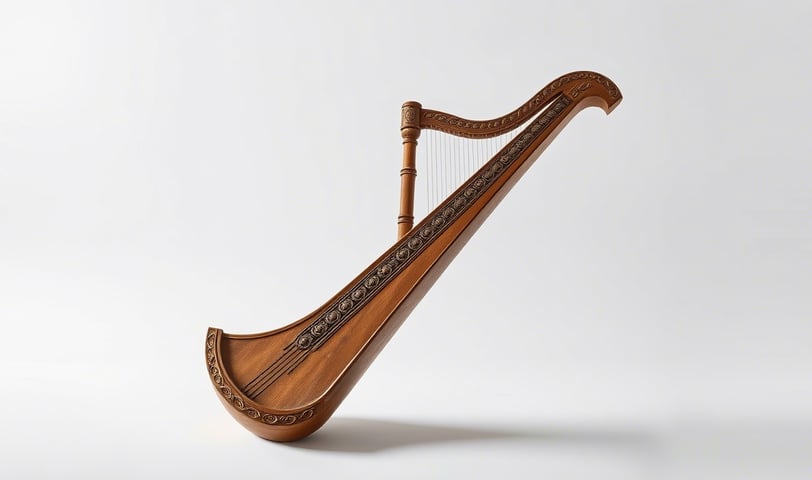

The ancient harp was typically constructed with a triangular frame and strings made from animal gut or plant fibres. Its design allowed for the creation of a resonating sound that captivated listeners. The cultural significance of the harp extended beyond mere entertainment; it often symbolized divinity and was frequently associated with religious rituals and ceremonies.
Lyre (3200 BCE)
A close cousin of the harp, the lyre symbolized culture in Ancient Greece and the Middle East. Its structure allowed for melody and harmony, laying the foundation for later stringed instruments.
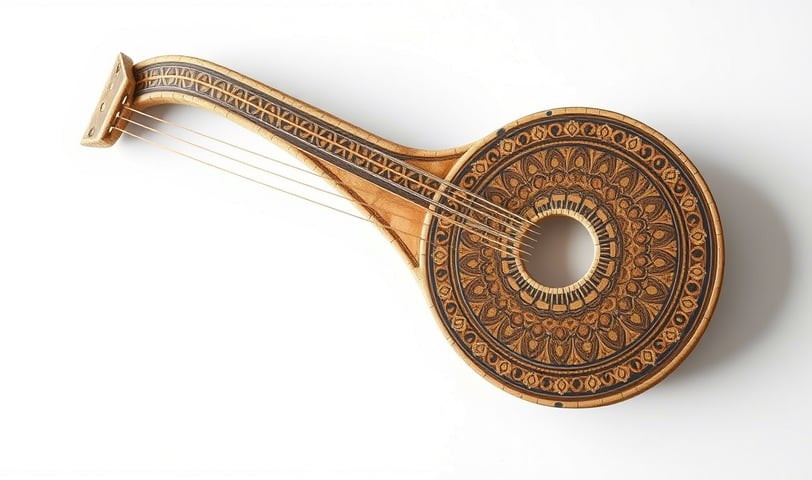

The lyre, on the other hand, features a different design, characterized by a U-shaped frame and a flat soundboard. Like the harp, it utilized gut strings, which produced a softer, yet equally enchanting sound. The lyre was particularly popular among the Sumerians and later the Greeks, where its role in music was not limited to performance alone; it was integral to storytelling and education, often accompanying poetry and oratory. Instrumentalists known as lyre players were respected members of society, illustrating the cultural reverence for these stringed instruments.
Variations of both the harp and lyre emerged as they spread across different regions, adapting to local tastes and musical styles. These variations demonstrate the versatility and enduring appeal of stringed instruments. Moreover, the techniques and playing styles developed during this period laid the foundation for future string instruments such as the guitar and violin, highlighting the profound influence of the ancient harp and lyre on the evolution of music throughout history. Their enduring legacy continues to resonate in various musical traditions today, reflecting the timeless bond between humanity and the art of music.
Trumpet (1500 BCE)
The earliest trumpets were found in the tomb of Tutankhamun in Egypt. Initially used for ceremonial or military purposes, these instruments relied on breath and lip tension, marking a new direction in wind music.

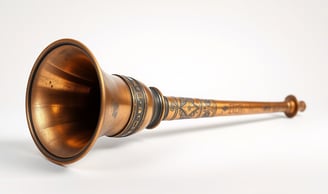
The historical development of musical instruments reflects the ingenuity of human beings in their quest for artistic expression. Among the earliest examples of brass instruments, the trumpet holds a significant place, with its origins dating back to approximately 1500 BCE in ancient Egypt. Constructed primarily from metal, early trumpets were often made from materials such as bronze or copper, which allowed them to produce distinct, resonant tones. Initially, these instruments were not designed for musical performance in the modern sense but rather served a variety of ceremonial and military purposes.
The trumpets of ancient Egypt were utilized in religious ceremonies and state rituals, emphasizing their importance in society. Their loud, piercing sound was ideal for signaling during battles or conveying important messages across vast distances. Furthermore, their usage in various rites underscored the connection between music and spirituality in ancient cultures. This early brass instrument thus emerged as not merely a tool for aesthetics but as an integral component of social and political life.
The evolution of brass instruments illustrates humanity's enduring relationship with music. From the simple yet powerful early trumpets of ancient civilizations to the intricate designs found today, the journey of these instruments showcases how cultural practices and innovations have shaped the soundscape of history. The trumpet, in particular, remains a symbol of this evolution, with its enduring presence in contemporary music genres while still echoing the significance it held in ancient times.
3. Classical Complexity and Musical Innovation
The ancient Greeks and Romans brought intellectual rigor to music. Instruments like the aulos and hydraulis (early organ) were not just entertainment tools—they were considered mathematical and philosophical devices.
The aulos, with its intense, nasal tone, was central to dramas, military events, and public ceremonies, influencing tastes toward energetic and emotional performance. The hydraulis organ introduced the power of polyphony and sustained tones, hinting at future cathedral sounds.
Music became a subject of study, and its role expanded into education, ethics, and medicine. Musical taste in this era emphasized order, balance, and technical execution. Scales and modes were tied to moods and moral values—playing Dorian vs. Phrygian scales wasn’t just artistic, but ethical. This belief system fostered a culture of intentional listening and composition, where music's purpose went beyond pleasure into discipline and intellect.
Aulos (800 BCE)
The aulos, a double-reed woodwind from Ancient Greece, often accompanied dramas and celebrations. Played with circular breathing, it required skill and stamina, showing increased musical complexity.
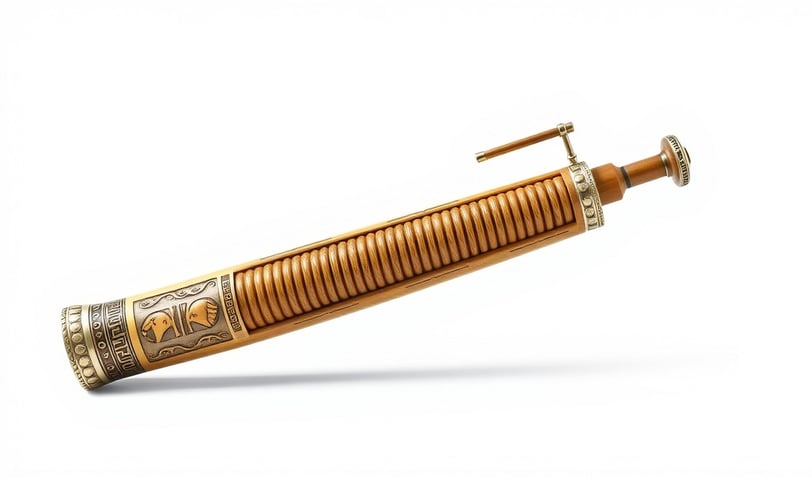

The aulos, a prominent double-reed instrument of ancient Greece, offers a fascinating glimpse into the interplay between culture and sound. Dating back to approximately 800 BCE, this instrument was often associated with various festivities, religious ceremonies, and theatrical performances. The aulos consists of two pipes played simultaneously, allowing for a rich, polyphonic texture that differentiates it from many of its contemporaries. Its sound is notable for being penetrating and vibrant, often considered both joyful and mournful, capturing the emotional range of Greek music. Moreover, the aulos was often used alongside other instruments in ensemble settings, thereby enhancing its cultural relevance in ancient Greek society.
Hydraulis aka Organ (250 BCE)
The hydraulis, created by Ctesibius of Alexandria, was powered by water pressure. As the first keyboard instrument, it marked a shift toward multi-note control and paved the way for the modern organ.
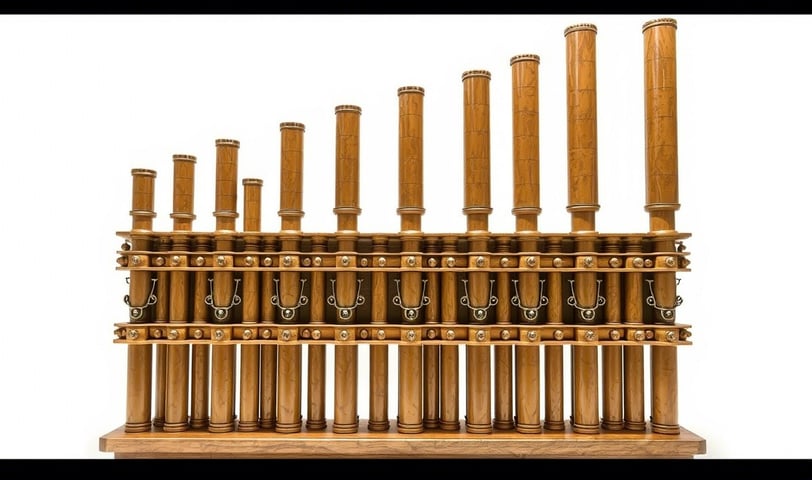

On the other hand, the hydraulis, invented by Ctesibius around 250 BCE, represents a significant technological milestone in the evolution of musical instruments. Recognized as the first known pipe organ, the hydraulis used water pressure to create wind that flowed through pipes, producing sound. This innovation not only expanded the potential for musical expression but also illustrated the intersection of engineering and art in ancient times. The hydraulis was frequently employed in public venues such as amphitheaters and gladiatorial arenas, further solidifying its role in both entertainment and community gathering.
The relationship between these two instruments highlights the diversity in sound production techniques and their respective cultural meanings. While the aulos embodies the spontaneous spirit of Greek tradition, the hydraulis signifies the advancement of engineering in music. Both instruments have left an indelible mark on the history of music, showcasing how different societies have devised unique approaches to create complex sounds. Their distinctive sound characteristics continue to resonate in discussions about ancient musical practices, influencing musicians and theorists in modern times.
4. Renaissance & Baroque Breakthroughs
The Renaissance and Baroque periods ignited an explosion in musical theory, performance, and craftsmanship. Instruments like the violin and piano redefined dynamics, range, and expressiveness.
The violin, with its voice-like tone and agile playability, became the emotional heart of both folk and chamber music. Meanwhile, the piano introduced touch-sensitive expression, offering performers nuance and control that reshaped taste toward introspective, melodic storytelling. These innovations came alongside evolving musical notation and harmony theory. Polyphonic music—where multiple melodies coexist—became the ideal, reflecting Renaissance humanism’s embrace of complexity and beauty.
The Baroque period intensified this with ornamentation, improvisation, and dramatic contrasts, feeding public taste for grandeur and spectacle. Instrumental music finally stood on its own, no longer just supporting voice or ritual. This era turned composers and performers into stars, setting the stage for solo virtuosity and emotional expression as musical ideals.
Violin (1520 CE)
Andrea Amati's violin represented craftsmanship and musical beauty. As the orchestra's emotional voice, it was beloved in both folk and classical traditions.

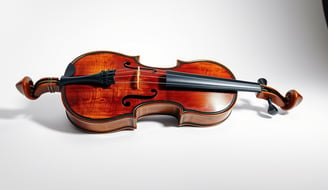
The violin, believed to have been developed in the 1520s, gained prominence during the Renaissance era. Its design was refined over centuries, particularly by Italian luthiers such as Antonio Stradivari and Guarneri, leading to the iconic shapes and structures seen today. The violin became a fundamental instrument in orchestras, capturing the expressive nuances of the human experience through its versatile dynamics and tonal range.
Piano (1700)
Invented by Bartolomeo Cristofori, the piano allowed players to control dynamics (soft and loud) through touch. It quickly became a centrepiece in Western music, from solo works to symphonies.
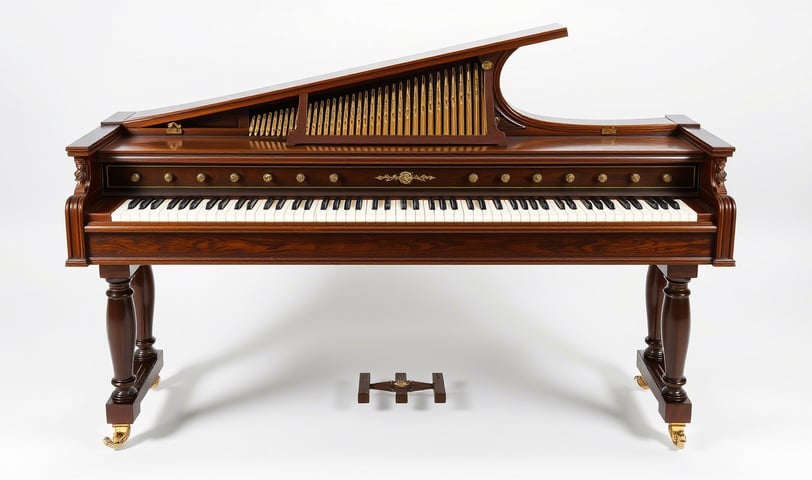

As the tradition of violin craftsmanship continued to flourish, the creation of the piano in the early 18th century marked another significant era in the evolution of musical instruments. Invented by Bartolomeo Cristofori around 1700, the piano differentiated itself from prior keyboard instruments with the capability of producing both soft and loud sounds, hence its name derived from "forte-piano." The piano's construction evolved, integrating innovations such as the usage of iron frames and advanced key actions, which improved tuning stability and responsiveness. This made the piano a favoured instrument among composers and performers, allowing for greater expression and technically demanding compositions.
The 18th and 19th centuries witnessed transformative changes in the music landscape, with both the violin and piano influencing and shaping the compositions of renowned composers like Bach, Mozart, and Beethoven. Their contributions redefined musical expression, leading to the emergence of new genres and styles. Following these developments, additional instruments such as the harmonica and accordion gained traction, further diversifying the sonic palette available to musicians. These inventions illustrated the ongoing ingenuity prevalent in the world of music, showcasing mankind's unwavering desire to explore sound and creativity.
5. Industrial and Popular Age Instruments
The 19th century brought mass production, portability, and new sound possibilities to music. Instruments like the harmonica, accordion, saxophone, and harmonium emerged from technological innovations that democratized music-making. No longer confined to courts or churches, music became accessible to the everyday person.
The harmonica and accordion fit working-class and rural lifestyles, influencing folk traditions in Europe and the Americas. Their portability meant music could travel—on trains, across oceans, into parlors and street corners. The saxophone, with its dynamic tone, bridged classical and jazz worlds, becoming a symbol of freedom and rebellion by the 20th century. The harmonium’s use in Indian music added cross-cultural richness.
Musical taste during this period diversified wildly: romantic orchestras, village dances, spiritual hymns, and later jazz all coexisted. This era expanded the audience, the genres, and the idea that music could be both personal and political, formal and spontaneous.
Harmonica (1821)
German inventor Christian Friedrich Buschmann created the harmonica, a compact wind instrument loved in blues, folk, and country music. Its portability and expressive capabilities made it a favourite among traveling musician
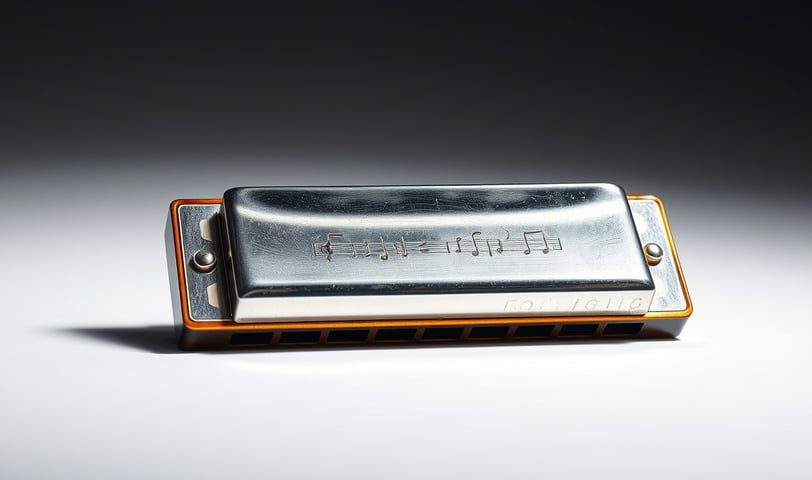

The harmonica emerged in 1821 through the innovative work of Christian Friedrich Buschmann, a German instrument maker who revolutionized portable music-making forever. Buschmann's creation, initially called the "Aura," represented a breakthrough in free-reed technology that transformed how ordinary people could access musical expression. Unlike the complex and expensive instruments of the era, the harmonica offered an affordable, pocket-sized solution that democratized music across social classes. Its ingenious design featured metal reeds mounted within a compact wooden or metal frame, allowing players to produce melodic sounds through simple breath control.
The instrument's construction utilized precisely tuned brass or steel reeds that vibrated when air passed over them, creating distinct pitches through inhalation and exhalation. This dual-action mechanism enabled players to achieve remarkable versatility within a surprisingly small form factor. The harmonica's portability made it an instant companion for travellers, workers, and musicians who needed a reliable instrument that could withstand harsh conditions while delivering consistent performance.
Cultural adoption of the harmonica spread rapidly across Europe and America, becoming particularly associated with folk traditions, blues music, and later country and rock genres. The instrument found special resonance among working-class communities, cowboys, and migrants who valued its durability and convenience. The harmonica's influence on popular music became integral to defining American blues and folk, proving that profound innovations often come in the smallest packages.
Accordion (1829)
Invented by Cyrill Demian in Vienna, the accordion's bellows and keys offered a portable orchestra. It became central to folk music in Europe, South America, and beyond.


The accordion was invented in 1829 by Cyrill Demian, an Armenian-Austrian instrument maker in Vienna, who created what he called the "Accordion" from the German word "Akkord" meaning harmony. Demian's revolutionary design combined free-reed technology with a bellows system, allowing musicians to produce sustained notes and dynamic expression previously impossible with portable instruments. His patent described a compact instrument featuring metal reeds, a bellows mechanism, and buttons that could produce multiple notes simultaneously, creating rich harmonic textures that captivated audiences across Europe.
The instrument's ingenious construction utilized a folding bellows operated by the player's arms, forcing air across precisely tuned metal reeds to create sound. Unlike its predecessor the harmonica, the accordion's bellows system provided continuous airflow control, enabling players to achieve remarkable dynamic range and sustained musical phrases. The button layout allowed for complex chord progressions and melodic lines, making it suitable for both solo performances and ensemble playing. This versatility quickly established the accordion as a cornerstone of folk music traditions.
Cultural adoption of the accordion spread rapidly throughout Europe and immigrant communities worldwide, becoming integral to polka, folk, tango, and cajun music traditions. Its portability and volume made it perfect for dance halls, street performances, and community gatherings. The accordion's influence shaped regional musical identities from Eastern European polkas to South American tangos, demonstrating how innovative instrument design can define entire musical cultures and social experiences.
Saxophone (1840)
Adolphe Sax created the saxophone by blending woodwind tone with brass body design. It found a voice in jazz, classical, and pop, becoming an icon of musical innovation.
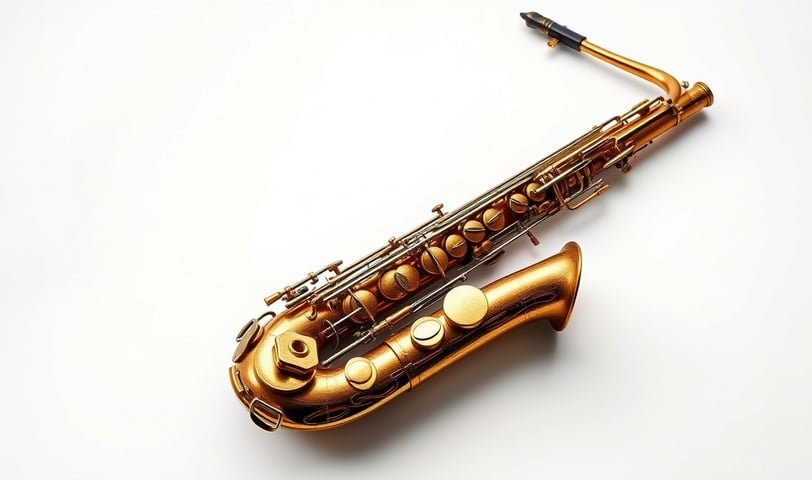

The saxophone was invented in 1840 by Adolphe Sax, a Belgian instrument maker who sought to bridge the gap between woodwind and brass instruments. Sax envisioned an instrument that combined the flexibility and expressiveness of woodwinds with the power and projection of brass instruments. His revolutionary design featured a conical brass body with a single-reed mouthpiece similar to a clarinet, creating an entirely new timbral category. The saxophone's unique construction allowed for unprecedented dynamic range and tonal versatility, making it capable of both subtle whispers and powerful declarations that could cut through orchestral textures.
The instrument's technical innovation lay in its sophisticated key system and conical bore design, which enabled smooth transitions across its full range while maintaining consistent intonation. Sax developed multiple sizes from soprano to bass, creating a complete family of instruments that could function both as solo voices and ensemble sections. The saxophone's fingering system, borrowed from woodwind traditions, made it accessible to musicians already familiar with clarinet or oboe techniques, facilitating rapid adoption among professional players.
Cultural impact of the saxophone extended far beyond Sax's original military band intentions, becoming the defining voice of jazz music and later rock and popular music. Its expressive capabilities made it perfect for improvisation and emotional expression, establishing it as a symbol of musical freedom and creativity. The saxophone's journey from military bands to jazz clubs demonstrates how innovative instruments can transcend their original purpose to become cultural icons.
Harmonium (1842)
Alexandre Debain’s harmonium used air pumped through reeds via foot pedals. Popular in Indian classical music and European churches, it was a blend of organ and accordion principles.


The harmonium was invented in 1842 by Alexandre Debain, a French instrument maker who revolutionized sacred and domestic music through his innovative reed organ design. Debain's creation addressed the need for a portable, affordable alternative to pipe organs that could serve churches, homes, and traveling musicians. His harmonium utilized free-reed technology combined with foot-operated bellows, allowing sustained musical expression without requiring the massive infrastructure of traditional pipe organs. The instrument's compact wooden case housed precisely tuned metal reeds and a sophisticated air distribution system that enabled rich, organ-like tones accessible to ordinary households and small congregations.
The harmonium's construction featured foot pedals that operated bellows systems, forcing air through carefully arranged reed chambers activated by a keyboard mechanism. This design provided consistent air pressure and volume control, enabling players to achieve dynamic expression and sustained harmonic textures. Multiple reed ranks and stops allowed for tonal variety, making the harmonium suitable for both simple hymn accompaniment and complex classical repertoire. Its portability and reliability made it an instant favourite among missionaries, traveling performers, and rural communities lacking access to pipe organs.
Cultural adoption of the harmonium spread globally, becoming integral to Indian classical music, Christian worship, and folk traditions worldwide. In India, the harmonium transformed musical practice by providing harmonic accompaniment to vocal traditions, while Western missionaries carried it across continents. The harmonium's democratic accessibility helped preserve and spread musical traditions, proving that innovative design can bridge cultural boundaries and democratize musical expression across diverse communities.
6. The Rise of Electricity and Electronic Sound
The 20th century saw music electrified—literally. Instruments like the theremin, electric guitar, and Moog synthesizer disrupted everything known about sound creation. The theremin introduced a futuristic, touchless experience, influencing sci-fi culture and avant-garde composers.
The electric guitar revolutionized genres like rock, blues, and funk, giving birth to guitar heroes and signature sonic identities. The Moog synthesizer was a game-changer, allowing composers to shape waveforms into entirely new textures.
Suddenly, music wasn’t limited to acoustic properties—it became sculptable. Tastes shifted toward boldness, distortion, abstraction, and rhythm-based energy. Genres like psychedelia, funk, disco, and synthpop reflected this synthetic sound revolution. Music videos, global radio, and vinyl spread these styles across borders, standardizing some tastes and fragmenting others. This period made the studio an instrument and the producer a new kind of artist. Sound became limitless, and audiences craved the surreal, the futuristic, and the emotionally charged.
Theremin (1920)
Léon Theremin’s invention allowed musicians to play without touching the instrument. By manipulating electromagnetic fields, the theremin produced eerie gliding tones—perfect for sci-fi soundtracks.


The theremin was invented in 1920 by Léon Theremin, a Russian physicist who accidentally discovered the world's first electronic musical instrument while working on proximity sensors for the Soviet government. Theremin's revolutionary creation utilized radio frequency oscillations and electromagnetic fields to produce sound without any physical contact, marking humanity's first venture into electronic music synthesis. The instrument consisted of two metal antennas protruding from a wooden cabinet, with the vertical antenna controlling pitch and the horizontal loop controlling volume. This ethereal design allowed performers to create music through precise hand movements in the air, producing haunting, otherworldly tones that seemed to emanate from thin air itself.
The theremin's technical operation relied on heterodyning principles, where two radio frequency oscillators created audible beat frequencies when interrupted by the performer's proximity. The player's hand movements altered the electromagnetic field around the antennas, changing capacitance and thus modifying the oscillator frequencies to produce different pitches and volumes. This unprecedented interface required exceptional spatial awareness and muscle memory, making the theremin one of the most challenging instruments to master. Its continuous pitch capability enabled microtonal expression impossible on traditional fixed-pitch instruments.
The theremin was invented in 1920 by Léon Theremin, a Russian physicist who accidentally discovered the world's first electronic musical instrument while working on proximity sensors for the Soviet government. Theremin's revolutionary creation utilized radio frequency oscillations and electromagnetic fields to produce sound without any physical contact, marking humanity's first venture into electronic music synthesis. The instrument consisted of two metal antennas protruding from a wooden cabinet, with the vertical antenna controlling pitch and the horizontal loop controlling volume. This ethereal design allowed performers to create music through precise hand movements in the air, producing haunting, otherworldly tones that seemed to emanate from thin air itself.
Electric Guitar (1931)
George Beauchamp’s "Frying Pan" revolutionized performance. Amplified strings allowed for sustained sound and distortion, fuelling the birth of rock and roll.
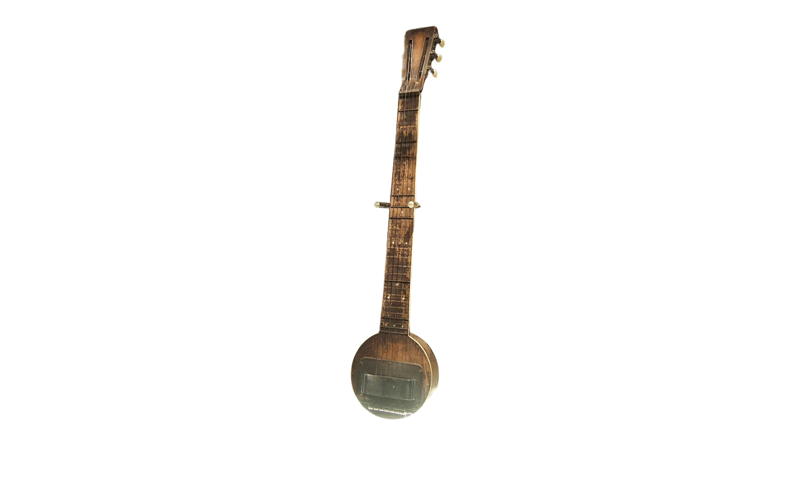

The world's first electric guitar was invented in 1931 by George Beauchamp, an American musician and inventor who revolutionized popular music through his innovative "Frying Pan" design. Beauchamp collaborated with Adolph Rickenbacker to create this groundbreaking instrument, officially called the Rickenbacker Electro A-22, which earned its nickname from its distinctive circular aluminum body and long neck resembling a kitchen utensil. This pioneering creation addressed the fundamental problem of acoustic guitars being overpowered by louder instruments in jazz ensembles and dance bands. Beauchamp's electromagnetic pickup system converted string vibrations into electrical signals that could be amplified, forever changing how guitars could be heard and integrated into musical arrangements.
The "Frying Pan's" technical innovation centered around Beauchamp's horseshoe pickup design, featuring two horseshoe-shaped magnets that surrounded the strings with a coil of wire wrapped around them. When steel strings vibrated within this magnetic field, they induced electrical currents in the coil, creating the first successful magnetic pickup system. The instrument's cast aluminum body eliminated feedback issues while providing sustain, and its solid construction offered durability superior to traditional hollow-body guitars. This revolutionary pickup technology became the foundation for all subsequent electric guitar development.
Cultural impact of the electric guitar transformed popular music entirely, enabling the birth of blues, rock and roll, and countless other genres. The amplified guitar's ability to sustain notes, achieve dynamic volume changes, and cut through dense musical arrangements made it the defining instrument of twentieth-century popular culture, proving that technological innovation could reshape artistic expression on a global scale.
Moog Synthesizer (1964)
Robert Moog’s synthesizer brought modular synthesis into studios. With it came limitless sound design possibilities, used by artists from Pink Floyd to Kraftwerk.
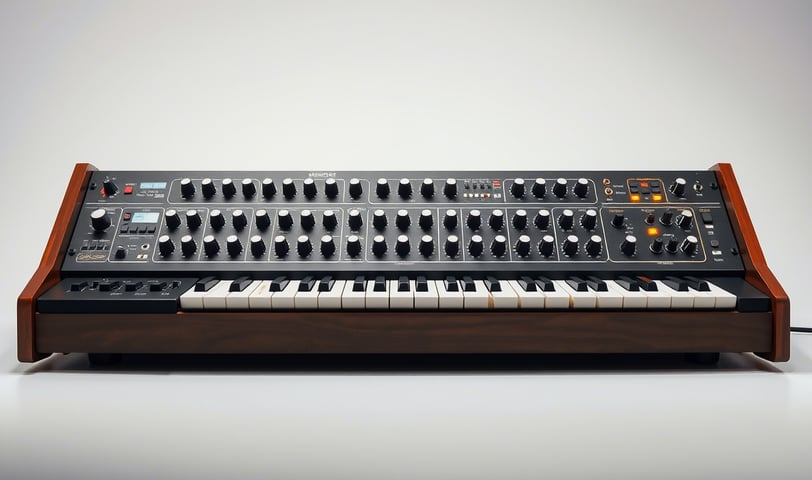

The Moog synthesizer was invented in 1964 by Robert Moog, an American engineer and electronic music pioneer who transformed sound synthesis from a laboratory curiosity into a practical musical instrument. Moog's revolutionary modular design allowed musicians to create and manipulate electronic sounds using voltage-controlled oscillators, filters, and amplifiers connected through patch cables. Unlike previous electronic instruments that produced fixed tones, the Moog synthesizer offered infinite sonic possibilities through its subtractive synthesis approach, where complex waveforms were shaped and filtered to create entirely new sounds. This ground-breaking instrument made electronic music accessible to composers and performers, establishing the foundation for modern electronic music production.
The synthesizer's technical innovation lay in its voltage-controlled modules that could be interconnected in countless configurations. Moog's oscillators generated basic waveforms like sawtooth, square, and triangle waves, while his famous ladder filter could sweep through frequencies to create expressive, singing tones. The instrument's keyboard interface made it familiar to traditional musicians, while its modular patch-bay system enabled experimental sound design. Each module responded to control voltages, allowing for complex modulation effects, sequencing, and real-time performance manipulation that had never been possible with acoustic instruments.
Cultural impact of the Moog synthesizer revolutionized popular music across genres, from progressive rock and electronic music to funk and hip-hop. Artists like Wendy Carlos, Keith Emerson, and Parliament-Funkadelic used the Moog to create iconic sounds that defined entire musical movements. The synthesizer's influence extended beyond music into film scores, sound design, and audio production, proving that electronic innovation could fundamentally alter how humanity creates, experiences, and conceptualizes musical expression.
7. The Digital & Artificial Intelligence Era
The digital revolution forever changed the way music is made, shared, and consumed. MIDI controllers, digital audio workstations (DAWs), and AI music generators enabled anyone with a laptop to become a composer, producer, or performer.
MIDI brought precision and automation, while DAWs like FL Studio and Logic Pro turned entire studios into software environments. AI generators like AIVA and Amper go a step further, composing in real-time using vast datasets of human-created music.
This era’s defining trait is accessibility—music is no longer gated by resources or training. Taste has diversified dramatically: some crave algorithmic perfection, others yearn for human rawness. Genres blur, lo-fi beats stream on 24/7 YouTube channels, and TikTok virality often dictates popular trends. Creativity is now augmented by code, not just chords. This era's musical identity is dynamic, decentralized, and co-created with machines—shifting taste toward experimentation, immediacy, and hyper-personalization.
MIDI Controller (1983)
The MIDI (Musical Instrument Digital Interface) controller enabled instruments and computers to communicate. It unlocked digital composition, layering, and sequencing, forming the backbone of electronic music.
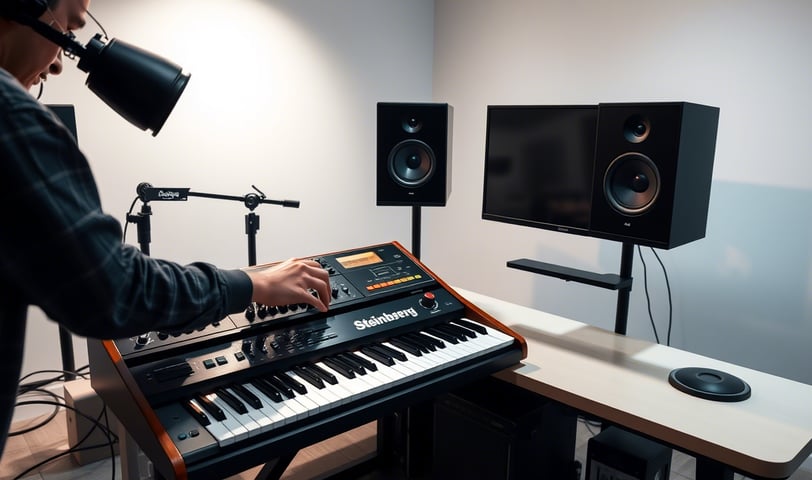

The world's first MIDI controller keyboard was unveiled in 1983 when Sequential Circuits released the first commercial MIDI keyboard controller called the Six-Trak, revolutionizing how electronic instruments communicated with each other. This ground-breaking instrument emerged from Dave Smith's vision of a "Universal Synthesizer Interface," which he had proposed in 1981 to solve the growing incompatibility crisis between different manufacturers' synthesizers. The MIDI specification was published in August 1983, and MIDI was launched at the 1983 Winter NAMM where a Sequential Circuits Prophet 600 was successfully demonstrated connected to a Roland Jupiter-6. This historic moment marked the birth of modern electronic music production, enabling musicians to control multiple instruments from a single keyboard interface.
The Six-Trak's technical innovation lay in its comprehensive control interface, featuring assignable knobs, sliders, and wheels that allowed users to tweak parameters and shape sounds in real-time while playing. The MIDI protocol transmitted digital messages over a simple 5-pin cable, communicating note information, velocity, timing, and control data between compatible devices. This standardized communication eliminated the need for multiple keyboards and created unprecedented flexibility in studio and live performance setups. Musicians could now layer sounds, sequence complex arrangements, and control entire electronic orchestras from a single controller.
Cultural impact of MIDI controllers transformed music production from an exclusive studio craft into an accessible art form. The democratization of electronic music creation enabled bedroom producers, independent artists, and composers worldwide to create professional-quality recordings. MIDI's influence extended beyond music into film scoring, video game soundtracks, and digital audio workstations, establishing the foundation for modern computer-based music production and forever changing how humanity creates, records, and experiences music.
Digital Audio Workstation (1989)
Steinberg Cubase introduced the modern DAW, replacing analog tape with digital multitrack recording and virtual instruments. DAWs like FL Studio, Logic Pro, and Ableton became the go-to tools for producers globally.
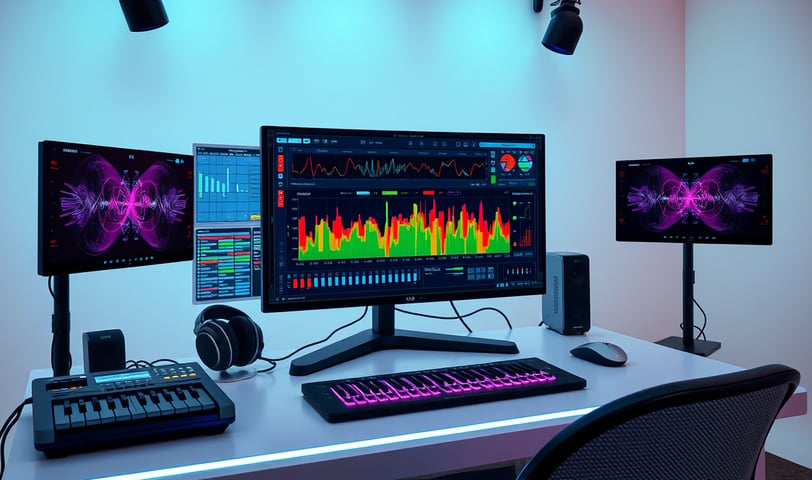

The digital audio workstation was pioneered in 1989 when Steinberg released Cubase, initially as a MIDI sequencer for the Atari ST computer, fundamentally transforming music production from analog tape-based recording to digital computer-based creation. Originally called Cubeat, this groundbreaking software was designed for the Atari ST platform, which was popular with musicians due to its built-in MIDI capabilities. The first version of Cubase was notable for the introduction of the clever MROS (MIDI Real-time Operating System) protocol, an early spiritual predecessor of the Steinberg/Propellerhead ReWire system, which allowed unprecedented multitasking and data transfer between programs. This innovation marked the beginning of the modern DAW era, where entire recording studios could be condensed into a single computer system.
Digital audio recording followed in 1992 with Cubase Audio, followed by VST support in 1996, which made it possible for third-party software programmers to create and sell virtual instruments. The evolution from MIDI sequencing to full audio recording capabilities represented a quantum leap in accessibility and functionality. Musicians could now record, edit, and mix multiple audio tracks alongside MIDI data, creating complex arrangements without expensive hardware mixers or tape machines. The integrated approach eliminated the need for separate sequencers, multitrack recorders, and mixing consoles, democratizing professional-quality music production.
Cultural impact of DAWs revolutionized the music industry by making professional recording accessible to bedroom producers, independent artists, and home studios worldwide. The shift from hardware-dependent studios to software-based production enabled countless genres to emerge, from electronic dance music to hip-hop, while empowering artists to maintain creative control over their entire production process. DAWs became the foundation of modern music creation, proving that digital innovation could fundamentally reshape artistic expression and industry structures.
AI Music Generator (2020s)
Today, tools like AIVA and Amper can compose music with little to no human input. Using machine learning trained on vast libraries of music, these generators raise new questions about creativity and authorship.


AI music generators emerged as viable creative tools around 2020, with platforms like AIVA, Amper Music, and OpenAI's MuseNet demonstrating artificial intelligence's capacity to compose original musical works across diverse genres and styles. These revolutionary systems utilized deep learning algorithms trained on vast datasets of existing music to understand patterns, structures, and stylistic elements that define different musical traditions. Unlike previous algorithmic composition tools that followed rigid rules, AI generators employed neural networks to create contextually appropriate melodies, harmonies, and rhythmic patterns that could mimic human compositional intuition. This breakthrough represented humanity's first successful attempt to automate the creative process of music composition, challenging fundamental assumptions about artistic creation and machine intelligence.
The technical innovation of AI music generators relied on transformer architectures and recurrent neural networks that could process sequential musical data and generate coherent compositions. These systems analyzed millions of musical examples to learn relationships between notes, chords, and structural elements, enabling them to produce original works in specific styles or create entirely new musical combinations. Advanced models could respond to user prompts, generate music for specific moods or contexts, and even collaborate with human musicians in real-time. The technology's ability to understand musical context, emotional expression, and stylistic consistency marked a significant leap forward in artificial creativity.
Cultural impact of AI music generators sparked intense debates about creativity, authorship, and the future of human artistic expression. While some viewed these tools as threats to musical employment and authenticity, others embraced them as powerful creative collaborators that could inspire new musical possibilities and democratize composition for non-musicians. AI generators began influencing commercial music production, film scoring, and personalized music creation, establishing artificial intelligence as a legitimate participant in humanity's ongoing musical evolution.
Bonus Tips for a Musical Evolution Perspective
🎼 Study Soundscapes from Each Era
Listening to instruments from different eras helps producers and musicians understand how tone, dynamics, and purpose evolved.
🔍 Blend Old and New
Sampling lyres or bullroarers into a DAW-based beat creates genre-bending innovation—heritage fused with modernity.
💬 Engage with AI, Don’t Compete
AI music tools can’t replace human soul—but they can inspire. Use them for composition ideas, mixing shortcuts, or even generating new scales and chord progressions.
Conclusion: The Sound of Human Evolution
The journey of musical instruments mirrors human evolution—primitive, spiritual, scientific, and now digital. From Neanderthals humming into bone flutes to AI generating symphonies in seconds, our relationship with music is as dynamic as it is eternal. Rather than replacing tradition, every new invention expands the vocabulary of sound, proving that innovation and emotion can coexist in perfect harmony.











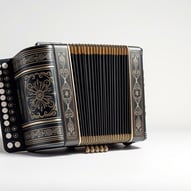


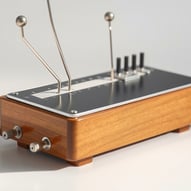





Chronological list of instruments from oldest to most advanced:
Bone Flute (43,000 BCE) - Neanderthal bone flutes found in Slovenia
Bullroarer (25,000 BCE) - Ancient spinning sound-maker used across cultures
Drums (8000 BCE) - Early frame drums in Mesopotamia
Harp (3500 BCE) - Ancient Sumerian harps
Lyre (3200 BCE) - Mesopotamian stringed instrument
Trumpet (1500 BCE) - Bronze Age Egyptian trumpets
Aulos (800 BCE) - Ancient Greek double-reed instrument
Organ (250 BCE) - Hydraulis invented by Ctesibius in Alexandria
Violin (1520) - Renaissance Italy, Andrea Amati
Piano (1700) - Bartolomeo Cristofori's gravicembalo col piano e forte
Harmonica (1821) - Christian Friedrich Buschmann
Accordion (1829) - Cyrill Demian in Vienna
Saxophone (1840) - Adolphe Sax
Harmonium (1842) - Alexandre Debain
Theremin (1920) - Léon Theremin's electronic instrument
Electric Guitar (1931) - George Beauchamp's "Frying Pan"
Moog Synthesizer (1964) - Robert Moog's modular synthesizer
MIDI Controller (1983) - Musical Instrument Digital Interface
Digital Audio Workstation (1989) - Steinberg Cubase
AI Music Generator (2020s) - Machine learning composition tools like AIVA, Amper
Follow us on Social Media
Follow Bomegaudio on your preferred social media platform for more music production insights, expert tips, gear reviews, private feedback and exclusive content tailored for producers like you.
Contact us
E-mail us directly on
© Bomegaudio 2025. All Rights Reserved.
Or use this form
Opening hours
[GMT+2 / CET]
Mondays :: Closed
Tue - Thu :: 05:00 - 20:00
Fri - Sat :: 05:00 - 22:00
Sundays :: Closed
420 Bomeg Avenue
Dank Francisco, BO

